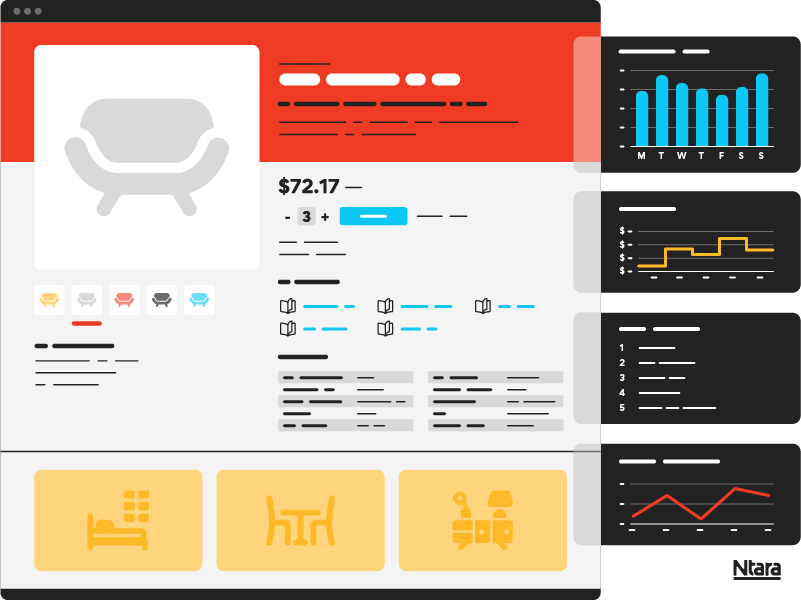Whether you sell B2B, B2C, or B2B2C, your online presence matters. The digital shelf opens the opportunity for higher revenue and satisfied customers.
Here’s the catch: Just like shoppers explore the aisles of a physical store, online customers expect a similar, if not superior, experience. They want to see products up close, read product details, check prices, and compare options — all from the comfort of their screens. And with so many choices, your competition is just a click away.
So, how can you foster a resilient digital shelf that always hits the mark? The answer lies in digital shelf analytics (DSA).

What is digital shelf analytics?
Digital shelf analytics uses intelligent automation to continuously monitor your online product listings. It generates real-time insights into product performance, customer behavior, and channel competition.
You might think DSA is just a software tool, but its success hinges on people and processes. Keep reading for a deeper look at how to get the most value from digital shelf analytics.
Why digital shelf analytics matters
To thrive in the digital landscape, it’s crucial to create top-notch product detail pages (PDPs) that captivate customers across the digital shelf. That includes reseller sites, search platforms, marketplaces, social media, your brand website, and more.
Within these touchpoints, your customer takes a journey of discovery, learning, comparison, and ultimately purchasing. Some may buy online, while others use online information to guide in-store purchases. That’s why it’s essential to ensure every listing is spot on.
Getting the content to each site and PDP requires product data syndication. PIM software makes this easier, but even PIM users run into issues. Digital shelf analytics acts as a guardian in these instances, helping address:

Poor product findability
Imagine a scenario where a single missing word causes your product to vanish from critical search results. Even minor issues like broken links or changes in Google’s algorithm can affect visibility. Digital shelf analytics helps you identify these issues in real-time, so you can make the necessary adjustments.

Eroding customer trust
Customers who purchase your products based on incorrect information often result in higher return rates and negative reviews. Subpar product information or blurry images can undermine trust in your brand, prompting customers to turn to your competitors instead. Digital shelf analytics helps you catch these issues across all channels – before they harm your sales and brand reputation.

Out of stocks
Seeing “out-of-stock” is a common frustration for customers on the digital shelf. DSA serves as your early warning system, alerting you whenever your stocks run low. This ensures you can stay ahead of demand, minimize disruptions, and optimize profitability.
How DSA technology works
DSA can act as a digital guardian. But how does it actually work?
The technology uses software known as “spiders” to crawl the sites where your products appear. These spiders collect data, which routes back into a feedback loop to update your dashboards and reports.
Here’s the thing: Not all spiders are the same. Some digital shelf analytics solutions use “high-frequency spiders,” which swarm websites multiple times a day. They often show up when sites are extra busy, which can slow down your product listing performance. Along with being pesky, they’re also less reliable.
To avoid these problems, look for software that uses high-quality, “ethical spiders.” Customized for each channel, they only visit during low-traffic times to protect speed and reliability. Ethical spiders also use AI to examine product information. This way, you get the most accurate picture of how your products are doing across the digital shelf.
How DSA benefits brands and manufacturers
Digital shelf analytics offers advantages for both brands and manufacturers selling via ecommerce.

Consumer brands can gain:
- Multichannel insights: DSA provides actionable insights into product performance across multiple online channels, ensuring your products shine at every digital touchpoint.
- Consistency: These insights help you align with the ever-evolving marketplace and reseller requirements, ensuring you tell a cohesive product story.

Manufacturers benefit from:
- Niche market profits: Digital shelf analytics is valuable even for manufacturers selling niche products on a limited number of websites. It offers performance data and reveals customer shopping behaviors, enabling the development of profitable product relationships.
- Strategic direction: Manufacturers, even those not currently selling online, can benefit from DSA. It provides essential insights for shaping strategies, meeting key performance indicators, and exploring opportunities like direct-to-consumer.
Five ways to improve your DSA results
Insights without purpose and a plan won’t make an impact. That’s why successful digital shelf analytics is the direct result of people + process + technology. Here are five ways to get the most value out of your DSA investment.

1. Assess your readiness
Before you dive into cost or effort, determine if your organization is ready for DSA. How’s your data maturity? Do you need to address PIM first? You may also need to build a business case for DSA and establish how you’ll prove its value.

2. Map your product data lifecycle
Without understanding your product data lifecycle, you might not know where or why errors creep in. A map of your product data’s journey can help you trace how each channel receives this data. Did it come from a single trusted source? Is there a connection issue? Using a product data lifecycle map, you can pinpoint how and why a problem occurred and explore potential fixes.

3. Formulate a strategy
Digital shelf analytics provides newfound insights, and you’ll need to decide what those insights mean for your organization. Which errors take priority? What processes will require manual intervention? And where does automation make sense? DSA requires a well-thought-out strategy, including the data and metrics you’ll focus on and how you’ll respond and correct based on that intelligence.
To further improve your digital shelf analytics strategy, conduct a customer segmentation study to better understand your audience. This helps uncover valuable insight about their preferences and expectations—and about the effects of missing or inaccurate product information.

4. Set up and configure
Implementing DSA isn’t as simple as flipping a switch. It involves significant setup and configuration. Part of this process is bringing different teams together to assess their needs and collaborate on how they’ll use the tool. Another part is ensuring that the people + process + technology continue working as planned.

5. Navigate change
Chances are, digital shelf analytics is new territory for your organization. And the first time for anything can be challenging. As insights start rolling in, you’ll need to train your users on the next steps. What processes will they follow? Who is responsible for each task? How can you boost their confidence in their actions and the results they’ll achieve? It’s all about guiding your team and setting them up for success.
See how we’ve helped businesses like yours navigate this type of digital transformation.
How to choose the right digital shelf analytics solution
Now, let’s talk about software. There are plenty of options, and it’s essential to select the right system for your needs. So, what are your options?

Standalone digital shelf analytics tool
A standalone DSA tool can provide visibility into your online product performance. However, if the tool is siloed, you may not have the closed-loop functionality to move the needle.
Combining PIM + digital shelf analytics
Digital shelf analytics tends to work best for organizations that are already on a PIM journey. Why? Because it’s easier to remediate issues when you have centralized data that’s easily syndicated to each channel.
Combining PIM + DSA is a powerful way to leverage closed-loop feedback, i.e., enriching and re-optimizing your product listings based on data intelligence.
You can approach PIM + DSA in several ways:
- Wondering if you need PIM? It’s a good idea to do so before you consider DSA. An experienced data partner can help you look at your data needs holistically, helping align your technology strategy with your business objectives.
- Currently evaluating PIM? If you’re already on the journey, consider whether your desired platform offers a digital shelf analytics component. Often, this is an add-on module that can be activated when you’re ready. A solution that brings PIM + DSA together is a powerful way to win on the digital shelf.
- Already have PIM? That’s great! In most cases, you can connect certain standalone DSA solutions to your existing PIM implementation. Your software may even have an integrated DSA tool you can add to your license. With so many options, it helps to have an expert guiding the way.
Let’s talk.
At Ntara, we’re passionate about helping brands and manufacturers win on the digital shelf. Our consultants understand the nuances of designing a unified data practice aligned perfectly to your needs.
Curious about PIM or DSA for your business? Schedule a no-pressure meeting with a member of our experienced team.